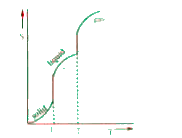Here T1andT2 are
 Solution in Telugu
Solution in Telugu
M, P, B, P
B.P, B.P
B.P, M.P
M. P, M.P
The correct Answer is:A
at MP and BP, entropy increases at constant T.
Topper's Solved these Questions
- CHEMICAL THERMODYNAMICSBOOK - AAKASH SERIESCHAPTER - CHEMICAL THERMODYNAMICSEXERCISE - PRACTICE SHEET (EXERCISE- III) (LEVEL- II (ADVANCED) (STRAIGHT OBEJCETIVE TYPE QUESTIONS)
9 Videos
- CHEMICAL THERMODYNAMICSBOOK - AAKASH SERIESCHAPTER - CHEMICAL THERMODYNAMICSEXERCISE - PRACTICE SHEET (EXERCISE- III) (LEVEL- II (ADVANCED) (MORE THAN ONE CORRECT ANSWER TYPE QUESTIONS)
8 Videos
- CHEMICAL THERMODYNAMICSBOOK - AAKASH SERIESCHAPTER - CHEMICAL THERMODYNAMICSEXERCISE - PRACTICE SHEET (EXERCISE- II) (LEVEL- II (ADVANCED) INTEGER TYPE QUESTIONS)
6 Videos
- CHEMICAL THERMODYANMICS BOOK - AAKASH SERIESCHAPTER - CHEMICAL THERMODYANMICS EXERCISE - Questions For Descriptive Answers
28 Videos
- ELECTRON MIGRATION EFFECTS BOOK - AAKASH SERIESCHAPTER - ELECTRON MIGRATION EFFECTS EXERCISE - QUESTIONS FOR DESCRIPTIVE ANSWERS
10 Videos
Similar Questions
Which has maximum entropy change of vaporisation?
View SolutionWhich statements are correct for a process involving an ideal gas?
View SolutionFor the reaction, N2(g)+3H2(g)→2NH3(g). Heat of reaction at constant volume exceeds the heat of reaction at constant pressure by the value of xRT. The value of x is______
View SolutionHow does heat of neutralisation value change with the chemical nature of acid and base?
View SolutionHyperconjugation effect is also termed as 'no bond resonance'. Why?
View SolutionIf the normals at points t1andt2 meet on the parabola, then t1t2=1 (b) t2=−t1−2t1 t1t2=2 (d) none of these
View Solution
Calculate a, T1,T2,T1'&T2'.
View SolutionWrite the correct number in the given boxes from the following A.P.
3,6,9,12,…….
Here t1=□,t2=□,t3=□,t4=□,t2−t1=□,t3−t2=□∴d=□
View SolutionWrite the correct number in the given boxes from the following A.P.
−3,−8,−13,−18,…..
Here, t1=□,t2=□,t3=□,t4=□,t2−t1=□,t3−t2=□∴a=□,d=□
View SolutionIf the tangents at t1andt2 to a parabola y2=4ax are perpendicular then (t1+t2)2−(t1−t2)2=
View SolutionHere T_(1) and T_(2) are
View SolutionThe area of triangle formed by the points points and t1,t2 and t3 on y3 =4ax is k|(t1−t2)(t2−t3)(t3−t1)| then K =
View SolutionSuppose
(x+a)n=T0+T1+T2+…+Tn
Then (T0−T2+T4−…)2+(T1−T3+T5−….)2 is equal to
View Solutionयदि (x+a)n के विस्तार में, T0,T1,T2,…. पद प्राप्त होते है, तो (T0−T2+T4−…)2+(T1−T3+T5−….)2 बराबर होगा
View SolutionIf t_(1)+t_(2)+t_(3)=-t_(1)t_(2)t_(3) , Then points [at_(1)t_(2),a(t_(1)+t_(2))] , [at_(2)t_(3),a(t_(2)+t_(3))] And [at_(3)t_(1),a(t_(3)+t_(1))] The perpendicular of the triangle with vertices will be
View Solution
